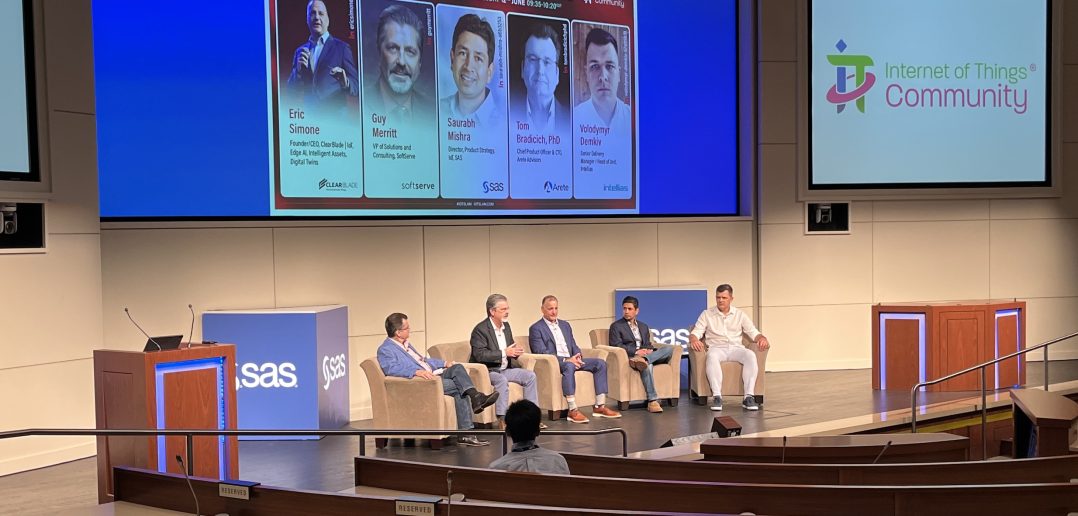GenAI's creative and analytical capabilities, integrated with IoT devices' connectivity and data insights, could lead to remarkable advancements. The market could become a mega-value creator, potentially exceeding $4.5 trillion by 2030.
Discussions around this convergence were the focal point of a panel during the 2024 IoT Slam held at SAS world headquarters.
Tom Bradicich, PhD, Chief Product Officer and Chief Technology Officer of Arete Advisors and moderator of the panel, invited featured leaders to voice opinions on real-world opportunities and challenges associated with GenAIoT. Panelists included:
- Saurabh Mishra, Director, Product Strategy, SAS.
- Eric Simone, Founder/CEO, ClearBlade.
- Guy Merritt, VP of Solutions and Consulting, SoftServe.
- Volodymyr Demkiv, Sr. Delivery Manager/Head of Unit, Intellias.
What are some major opportunities?
Merritt worked the crowd before answering questions about GenAIoT. He asked, “How many of you are generally familiar with GenAI? How many of your companies have it in production?”
When the crowd's responses to the two questions created polarization, Merritt said that’s what’s happening in the market, likening it to a familiar scenario he’s been hearing. "When I meet industry leaders, they often say, 'I really have to think about how we’re using Gen AI ... Why do we want to use GenAI?'"
“We have to be the trusted advisors to help leaders understand the business outcomes we’re trying to affect,” Merritt said. “How do we fuse [GenAI and IoT] into the day-to-day workflows to produce positive outcomes? What are the emerging opportunities?”
One of the key opportunities Merritt talked about was the application of GenAIoT to address an aging workforce in industries like manufacturing. According to research from The Manufacturing Institute, most manufacturing firms are both aware and concerned about the aging of their workforce. A key challenge in addressing this is that the aging workforce is not being replaced with skilled or experienced people fast enough.
Merritt offered a solution through the integration of GenAIoT. By incorporating this technology into the workforce, particularly in areas like predictive maintenance, GenAIoT can predict problems, assist in fixing them and guide workers through processes. This approach can help mitigate labor shortages in manufacturing and make the technology more accessible and practical.
Many in the IoT world are still cautious about GenAI, but amazing opportunities to address workforce concerns and other issues are buffering their concerns. While these opportunities sound good in theory, organizational leaders must first demystify and integrate these complex technologies to enhance efficiency and productivity. In short, awareness and knowledge will be key to success.
“The world doesn’t care unless it’s driving a solution.”
I nodded in agreement with that bar from Simone.
Simone was asked about his extensive work with digital twins, a concept that predates the current enthusiasm for GenAI but is now being fused with it. One barrier Simone says his company faced was the disconnect between technological advancements and practical applications.
“We’re a bunch of technologists, so we love talking about things like edge computing, IoT, data, GenAI and digital twins,” Simone said. “The reality is the world doesn’t care about those things unless they drive a solution.”
Simone explained that his team has evolved their approach to building IoT products. They’ve invested heavily in AI and digital twins, focusing on making these technologies accessible to everyday users.
"Once we realized how our customers were using our products and what was slowing them down, we invested heavily in allowing non-computer scientists to create operational digital twins – digital twins that are connected,” Simone said. “Digital twins are broad replicas of the physical world. Still, historically, they have been real but not connected. They were not operational digital twins."
Simone and his team value the ability to provide software that can be manipulated by operators – whether railroad operators, drillers or farmers – without requiring them to code.
“Our customers don’t need a complete model of the physical aspects of the device; they only need certain attributes,” Simone said. “With GenAI, you no longer need an operator; it automatically happens.”
What about data?
Well, what about it? GenAI's ability to synthesize data from various sources is impressive. It can gather data from machines, the environment, sensors, the IT world and even people.
“To my knowledge, we don't have a lot of technology that has done that before,” Merritt said.
Demkiv added that while widespread implementation has yet to occur, GenAI’s ability to analyze diverse data sets makes it a powerful tool for identifying bottlenecks and optimizing operations.
“It’s about how you configure the same data,” Demkiv said. “The more data you gather, the greater the statistical significance and insights you can achieve.”
In health care, for instance, GenAI can process voice-to-speech inputs and trained models to aid in computer vision and onboarding processes, significantly reducing the paperwork burden.
More quotes from the session
On moving beyond dashboards: Mishra talked about the importance of engagement over mere data presentation. “IoT is all about connectivity and instrumentation. Now, you have data coming at you fast and furious. AI helps you manage and process that data. We need to move beyond dashboards to actual engagement, where GenAI can provide insights in a language and format that users need.” He referenced the concept of “death by dashboard,” which essentially means insights rather than overwhelming data.
On security and ethical considerations: Simone later discussed the critical importance of security, saying, “Using these technologies carefully and slowly in a way that doesn’t upset systems is crucial. We can start to use these technologies to protect ourselves."
Watch this panel session on-demand
Mishra added that GenAI is only part of the solution. "In enterprise, it’s not just about text but also numbers. That’s why GenAI is only part of the stack. You still need existing systems and lay GenAI on top, working in conjunction."
Bradicich raised concerns about non-conventional military attacks. He stressed protecting critical infrastructure, such as water supplies, from enemy threats. "We must create technology that is measured and secure."
On trust and reliability: “Awareness is the huge elephant in the room,” Demkiv said. “Trustworthiness – how do you know the response is correct?”
If one thing was made clear, GenAIoT is set to transform industries by optimizing processes, enhancing decision making and overcoming workforce challenges. However, as I’m hearing a lot these days, it must be approached cautiously, ensuring security, trust and ethical considerations are at the forefront.

